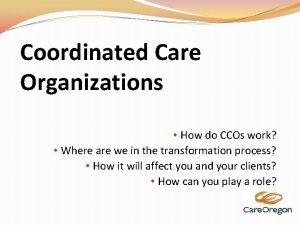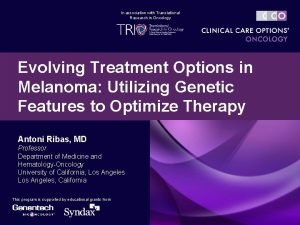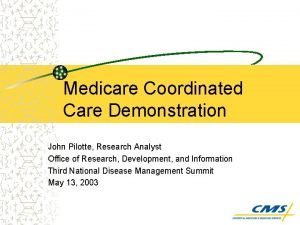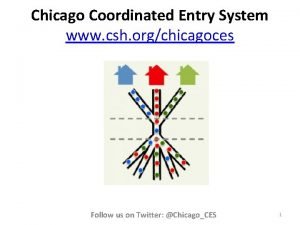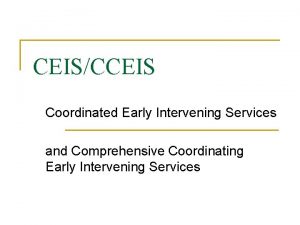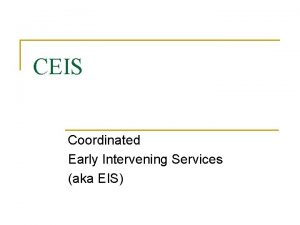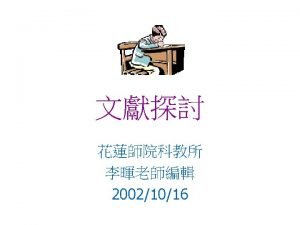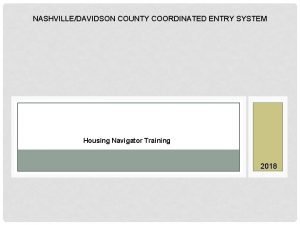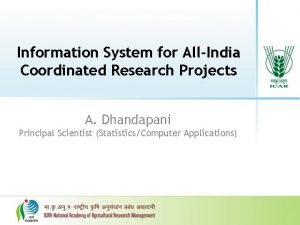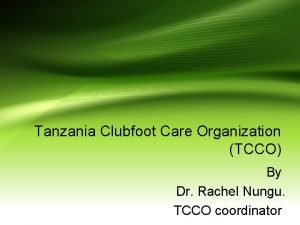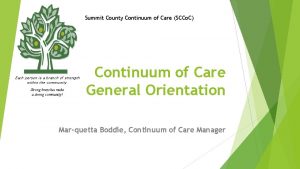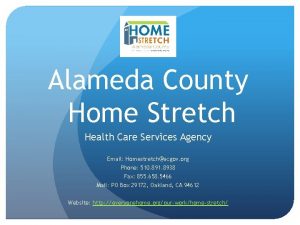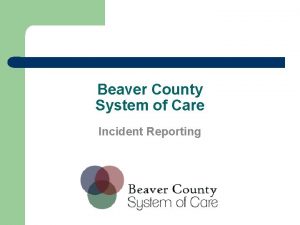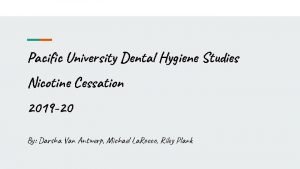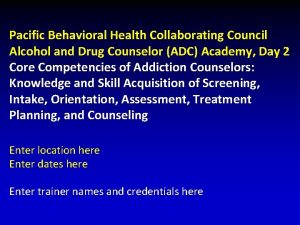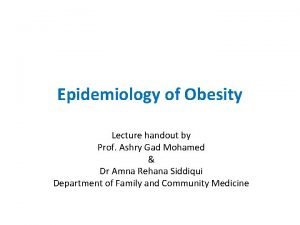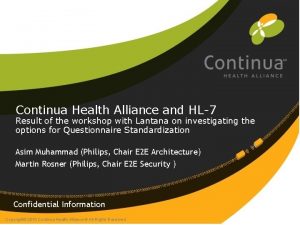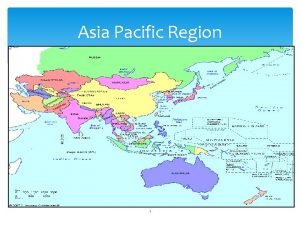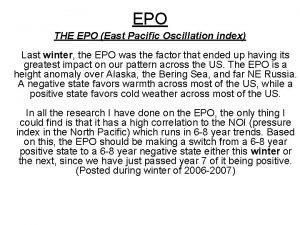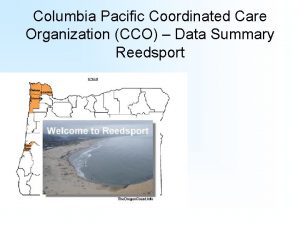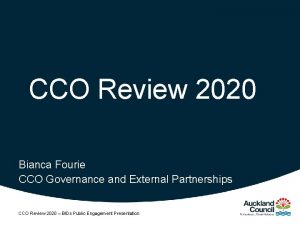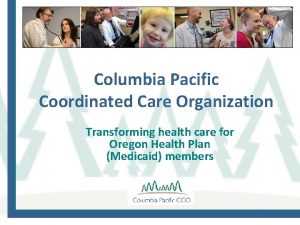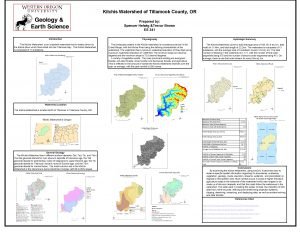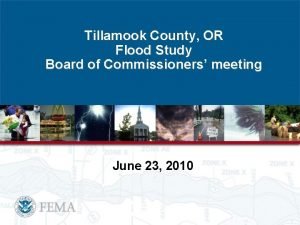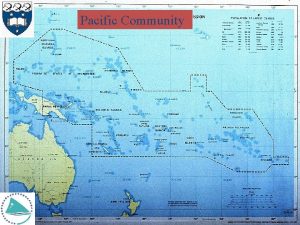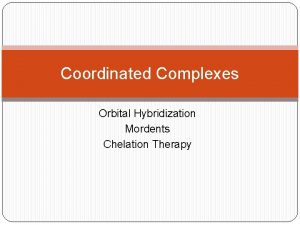Pacific Coordinated Care Organization CCO Tillamook County Data



























































































- Slides: 91

Pacific Coordinated Care Organization (CCO) – Tillamook County Data Summary


Fede Changes in Oregon Health Plan ral A c coun table Act D ua l. E lig ib ilit y Coordinated Care Organizations es r u s Healthcare Coordination & a e M Integration e c n a m fr or e P Community Advisory Councils / s Gl ic r t ob e al M Bu Prim ary C dg ets are Hea Fo lth H r. A ome ll s

OREG O COO N INTEG R R CARE DINATED & H DELI VERY EALTH SYST EM

OHP Client Physical Health • Assessment • Diagnosis • Treatment Plan (EBP) • Pre-set rate per service • Monitor / Update Mental Health • Assessment • Diagnosis • Treatment Plan (EBP) • Pre-set rate per service • Monitor / Update Addictions TX • Assessment • Diagnosis • Treatment Plan (EBP) • Pre-set rate per service • Monitor / Update Oral Health • Assessment • Diagnosis • Treatment Plan (EBP) • Pre-set rate per service • Monitor / Update

• Local Control (different CCO models) Coordinated Care Organizations • Coordination – Integrate Physical health, mental health, dental health– single point of accountability • Metrics / Performance Measures – Operate under contracted performance standards with clinical, financial and operational metrics • Global Budget And Shared Saving – More flexibility to manage dollars Primary Care Health Homes – Center of patients’ coordinated care. Includes a team that works on keeping patients at their healthiest. Community Advisory Council – Each CCO convenes a CAC to ensure that the health care needs of consumers are being addressed

CCO created a culture which allowed providers to bring these local activities into the next generation of integration Why This Why Now?

Better Health Care System Better Health Outcomes Cost Savings

Improve Health System, Improve Health Outcomes, Lower Costs All OHP Clients Early Assessment & Identification of High Risk For Chronic Disease At High Risk Chronic Disease Coordinated case management – Reduce likelihood become chronic Coordinated case management – Reduce high end costs

All OHP Clients Early Assessment & Identification of High Risk For Chronic Disease At High Risk Chronic Disease Coordinated case management – reduce likelihood become chronic Coordinated case management – Reduce high end costs

All OHP Clients Early Assessment & Identification of High Risk For Chronic Disease At High Risk Chronic Disease Coordinated case management – reduce likelihood become chronic Coordinated case management – Reduce high end costs

At High Risk Chronic Disease All OHP Clients Early Assessment & Identification of High Risk For Chronic Disease REA Coordinated case management – reduce likelihood become chronic LLY? Coordinated case management – Reduce high end costs Savings = reinvestment into system – incentive, etc.

Cost Impact Sample – Using Diabetes for A Single Oregon County: Number of Persons: Number of Deaths: Costs: If you can prevent 4. 67% of people from getting Diabetes: 9, 300 531 $42. 6 M If you can prevent 20% of people from getting Diabetes: Number Prevented: 437 1, 860 Lives Saved: 32 121 Financial Cost Savings: $2 M $8. 52 M

Cost Impact Sample – Using Diabetes for Douglas County: The risk of Type 2 Diabetes can be reduced by 50 -70% by control of obesity And by 30 -50% by increasing physical activity $8. 52 Million Question: What is the likelihood of preventing 5%, 10%, 20% of population from getting Diabetes? If you can prevent 4. 67% of people from getting Diabetes: If you can prevent 20% of people from getting Diabetes: Number Prevented: 437 1, 860 Lives Saved: 32 121 Financial Cost Savings: $2 M $8. 52 M

• Personal impact cannot be quantified • Can apply model to other chronic diseases – Each has risk factors which increase the likelihood of illness: Heart Disease and Stroke Prevention: • No tobacco • Physically active • Healthy weight • Healthy food choices • Preventing / controlling high blood pressure • 12 – 13 point reduction in average systolic blood pressure over 4 years reduces heart disease risk by 21%, stroke risk by 37% Cancer Prevention: • No tobacco • Limiting alcohol • Limited exposure to ultraviolet rays • Diet rich in fruits and vegetables • Maintaining a health weight • Being physically active • Seeking regular medical care

PCP Oral Health Addictions Mental Health

Health Integration System Family Behavioral Health Mental Health Spiritual Community Patients Dental Health Peers Providers Physical Health Neighborhood Health

• 15 CCO management areas Community Advisory Councils – Ensure health care needs of consumers are being met. Community / consumer focus within CCO’s work to accomplish vision – Improve Health Care System, Improve Health Outcomes, Lower Costs Current Goal – Identify 3 priority areas to improve health then identify strategies to reach that goal 18

National / State Studies: Higher death rates related to: • Heart disease • Stroke • Unintentional injuries Slightly higher rates of adult smoking and death rates related to alcohol induced diseases Increase in motor vehicle fatalities involving alcohol Higher rates of: • Smokeless tobacco by males • Drinking Limited access to health foods Higher percentage of reporting of depression/anxiety and high blood pressure (CP CCO Medicaid data) Summary of Findings Community Responses: Conditions create a healthy community: • Jobs • Access to healthy foods • Education / Schools Health problems in community: • Alcohol / drug addiction • High cost health care • Obesity 3 things to improve community health: • Health education services • Doctor appointments after five o’clock • Expand OHP

Poor Or Fair Health


Poor Physical Health Days

Poor Mental Health Days

Chronic Condition Diagnoses – Medicaid-eligible Population (CPCCO Service Area Chronic Health Conditions Percent told they have it by a physician (N= 1, 486) Of those percent currently taking RX for it Diabetes 9. 7 62. 4 High cholesterol 19. 1 45 High blood pressure 29. 6 57. 8 Depression / anxiety 44. 2 51. 8 Asthma 18. 2 51. 9 Emphysema / COPD 8. 2 50. 4 Heart attack / Angina 6. 6 50 2 69 Kidney problem 5. 1 33. 3 Cancer 3. 7 50 Congestive heart failure

Low Birthweight

Leading Cause of Death - Rate Per 100, 000 (5 year average) 2007 – 2011 Cause Heart Disease Tillamook County 224. 5. 0 Oregon 163. 1 Stroke 72. 5 47. 9 Unintentional Injuries 63. 8 41. 9 Suicide 18. 9 16. 2

Health Behaviors

Adult Smoking

Tobacco Use Smokeless (By Males)

Excessive Drinking

Binge Drinking

Heavy Drinking

Percent Motor Vehicle Fatalities Involving Alcohol

Death Rate from Alcohol-Induced - Diseases per 100, 000

Percent of Youth Who Had Drank Alcohol Past 30 Days (11 th Grade)

Percent of Youth Who Binge Drank in the Past 30 Days (11 th Grade)

Percent of Youth Who Drove When Drinking Alcohol (11 th Grade)

Death Rate from Drug-Induced Causes per 100, 000

Percent Who Used Illicit Drug(s) Other Than Marijuana in Past 30 Days

Percent of Youth Who Used Marijuana In Past 30 Days (11 th Grade)

Death Rate from Suicide per 100, 000

Percent of Youth Who Attempted Suicide in the Past Year (11 th Grade)

Percent of Youth Who Had Depressive Episode in the Past Year (11 th Grade)

DUI Rates Per 100, 000

Obesity and Access to Recreation

Obesity

Physical Inactivity

Access To Recreational Facilities

Limited Access To Healthy Foods

Fast Food Restaurants

Clinical Care

Uninsured

Preventable Hospital Stays

Diabetic Screening

Mammography Screening

Up-to-date Immunizations Among Two-year Olds

Mothers Receiving Inadequate Prenatal Care

Percent Age 20+ with Diabetes

Social, Economic, and Physical Environment

High School Graduation

Some College

Unemployment

Children In Poverty

Inadequate Social Support

Teen Birth Rate

Children in Single-parent households

Violent Crime Rate

A Look At Who We Are…

Age? Oregon = 38. 1 Tillamook County = 47. 4

Tillamook

Percent White / Caucasian

Percent Hispanic (all races)

Age 60 +

Under Age 18

Percent Male

Percent Who Speak Language Other than English At Home

Housing Vacancy Rate

Percent Households With Retirement Income

Percent Households with Social Security Income

Community Survey N = 338

1. In the past year, have you or anyone living in your home used health services at any of the following locations? Please select all that apply: Percent Number Hospital 54. 7% 185 Urgent care 34. 9% 118 Doctor’s office or other outpatient medical clinic 79. 9% 270 Veterans health Administration hospital or clinic 6. 5% 22 Addictions treatment center 2. 1% 7 Dental services 67. 5% 228 Public health department 22. 5% 76 Mental health / behavioral health or other counseling 13. 3% 45 911 10. 1% 34

2. What conditions exist now in your community to help create or foster good health? Please select all that apply: We have good doctors (They care about patients, provide good health care, etc. ) 75. 1% 254 We have local access to specialty services (A focus on specific area of care like a heart doctor) 31. 4% 106 There are good prevention services that help reduce health problems (Services that help people quit smoking or to eat healthy) 50. 3% 170 Citizens make use of recreational activities (Helps with exercising and stress reduction, etc. ) 40. 5% 137

3. What do you think are three (3) most important ways to create a healthier community? Please select only 3 A clean environment 27. 2% 92 Mental health treatment 18. 9% 64 Access to healthy foods 38. 5% 130 Food banks/hunger programs 16% 54 Affordable housing 28. 7% 97 Low crime/safe neighborhoods 15. 7% 53 Cultural acceptance 6. 5% 22 Sports and recreation activities 24. 3% 82 Education / Schools 33. 7% 114 29 Drug/alcohol prevention and treatment Health prevention and wellness education 24. 9% 84 Tobacco prevention / treatment 8. 6% services Job opportunities and a healthy 49. 4% economy 28. 1% 95 Better access to health care services 23. 7% 167 80

4. What do you think are three (3) most critical health problems in your community? (those problems which have the greatest impact on overall community health) Cancer 16. 6% 56 Respiratory/lung disease HIV/AIDS 3. 6% 12 2 Diabetes Heart disease / stroke 20. 7% 9. 8% 70 33 5% 17 Tobacco use 12. 4% 42 Obesity Mental Illness Alcohol/drug addiction 34. 9% 10. 4% 40. 5% 118 35 137 Dental problems 8. 6% Sexually transmitted diseases Suicide High blood pressure Lack of mental health treatment 14. 8% facilities High crime rates 1. 8% High cost of mental health services 5. 6% 50 Not enough doctors and clinics High cost of health care / lack of health insurance Too few recreational and exercise facilities Poor eating habits 5% 39. 9% 17 135 12. 4% 42 17. 8% 60 5. 9% 4. 4% 20 15 15 29 Lack of access to healthy foods Domestic violence Lack of transportation to medical facilities Too little affordable housing 14. 2% 48 3. 3% 11 Child abuse 3. 8% 13 7. 1% 24 Too few educational opportunities after high school (college, trade schools, et. ) 10. 1% 34 6 19

5. If you could pick just three (3) things to improve your community's access to health care, what would they be? Please pick only 3 boxes: More health education services 40. 5% 137 More doctors 26. 9% 91 More illness prevention services 28. 4% 96 More alcohol and drug treatment 30. 2% 102 More dentists 11. 8% 40 Doctor appointments after 5 pm or on weekends 35. 8% 121 More culturally sensitive care 5. 3% 18 Transportation assistance 15. 7% 53 More mental health services 23. 1% 78 Alternative health care 22. 5% 76 Expand the OHP (Medicaid) 30. 8% 104 More tobacco cessation programs 7. 4% 25

6. Think about the most recent time when you or a family member living in your home went without needed health care. What were the reasons why? Please check all that apply It costs too much 51. 5% 174 Don’t know where to go to get care 3. 8% 13 Don’t have insurance 33. 1% 112 Afraid of what they might find wrong with me 10. 4% 35 Childcare issues 1. 8% 6 Do not have a regular doctor 10. 9% 37 Transportation problems 9. 5% 32 Couldn’t get appointment quickly enough 16. 6% 56 Don’t like doctors 10. 7% 36 Waited for the health problem to go away 33. 1% 112 On the Oregon Health Plan, but do not 2. 4% have a doctor Doctor’s office not open 18. 6% when needed 8 63

7. Age

8. Gender

Income Race / Ethnicity: Less than $5, 000 12. 1% 38 American Indian or Alaska Native 2. 5% 8 $5, 000 - $15, 000 13. 7% 43 Asian 1. 3% 4 $16, 000 - $25, 000 11. 1% 35 Black or African American . 3% 1 $26, 000 - $40, 000 21% 66 Latino / Hispanic 12. 3% 39 $41, 000 - $70, 000 23. 9% 75 Native Hawaiian or Other Pacific Islander . 6% 2 $71, 000 - $100, 000 13. 4% 42 White 82. 9% 262 More than $100, 000 4. 8% 15

National / State Studies: Higher death rates related to: • Heart disease • Stroke • Unintentional injuries Slightly higher rates of adult smoking and death rates related to alcohol induced diseases Increase in motor vehicle fatalities involving alcohol Higher rates of: • Smokeless tobacco by males • Drinking Limited access to health foods Higher percentage of reporting of depression/anxiety and high blood pressure (CP CCO Medicaid data) Summary of Findings Community Responses: Conditions create a healthy community: • Jobs • Access to healthy foods • Education / Schools Health problems in community: • Alcohol / drug addiction • High cost health care • Obesity 3 things to improve community health: • Health education services • Doctor appointments after five o’clock • Expand OHP

“Community Health Needs Survey, - Tillamook County” 2013. Columbia Pacific Coordinated Care Organization : Community Advisory Council. Oregon. “County Health Calculator, ” 2013. Robert Wood Johnson Foundation and the Virginia Commonwealth University Center on Human Needs. “County Health Rankings and Roadmaps – A Healthier Nation County by County, ” 2013. Robert Wood Johnson Foundation and University of Wisconsin – Population Health Institute. “Data Elements for CCOs Reports, ” 2013. Oregon Health and Science University. Office of Rural Health. “Tillamook County’s Epidemiological Data on Alcohol, Drugs and Mental Health. 2000 to 2012. Oregon Health Authority. Office of Health Analytics and Addictions and Mental health Division. “Prevention Chronic Diseases and Reducing Health Risk Factors, ” 2013. Centers for Disease Control and Prevention. CDC 24/7 : Saving Lives. Protecting People. “Quick Facts, ” January 2013. Oregon Department of Human Services; Children, Adults and Families Division. Office of Business Intelligence and the Office of Forecasting, Research and Analysis.
 Tillamook family counseling center
Tillamook family counseling center Cisco cco id lookup
Cisco cco id lookup What is cisco cco id
What is cisco cco id Cco test questions
Cco test questions Oregon cco map
Oregon cco map Cco flag football
Cco flag football Clinicaloptions com oncology
Clinicaloptions com oncology Concept cco
Concept cco A consciously coordinated social unit composed
A consciously coordinated social unit composed Snohomish county coordinated entry
Snohomish county coordinated entry Cccplusva
Cccplusva John pilotte cms
John pilotte cms North pacific marine science organization
North pacific marine science organization Primary, secondary, tertiary care
Primary, secondary, tertiary care Pacific data hub
Pacific data hub Data structure operations
Data structure operations Process organization in computer organization
Process organization in computer organization Alternating pattern essay
Alternating pattern essay Coordinated management of meaning model
Coordinated management of meaning model Coordinated community response training
Coordinated community response training Coordinated management of meaning definition
Coordinated management of meaning definition Coordinated entry system chicago
Coordinated entry system chicago Introduction of retailing
Introduction of retailing Coordinated effort in retailing concept
Coordinated effort in retailing concept Accelegrants
Accelegrants Ceis meaning
Ceis meaning A series of coordinated related multiple projects
A series of coordinated related multiple projects A series of coordinated related multiple projects
A series of coordinated related multiple projects Modern project management
Modern project management Coordinated product and supply chain design
Coordinated product and supply chain design A series of coordinated related multiple projects
A series of coordinated related multiple projects Coordinated entry
Coordinated entry Coordinated border management
Coordinated border management Hmis nashville
Hmis nashville A series of coordinated related multiple projects
A series of coordinated related multiple projects A series of coordinated related multiple projects
A series of coordinated related multiple projects Alabama coordinated health network
Alabama coordinated health network All india coordinated research project
All india coordinated research project Coordinated plan on ai
Coordinated plan on ai Coordinated engagements
Coordinated engagements Tanzania clubfoot care organization
Tanzania clubfoot care organization Summit county continuum of care
Summit county continuum of care Heap westchester county
Heap westchester county Alameda county health care for the homeless
Alameda county health care for the homeless Beaver county system of care
Beaver county system of care Beaver county system of care
Beaver county system of care Standard 3 duty of care
Standard 3 duty of care Magnetul atrage corpurile ce contin
Magnetul atrage corpurile ce contin Palliative care versus hospice care
Palliative care versus hospice care Vietuitoare care se inmultesc prin oua
Vietuitoare care se inmultesc prin oua Care sunt simturile prin care sunt evocate
Care sunt simturile prin care sunt evocate Care certificate 13 answers
Care certificate 13 answers Hip fracture clinical care standard
Hip fracture clinical care standard Health and social care unit 2
Health and social care unit 2 Pacific theater timeline
Pacific theater timeline Pacific railway act
Pacific railway act Where does the pacific time zone start
Where does the pacific time zone start Temperate rainforest plants
Temperate rainforest plants All nonzero digits are significant.
All nonzero digits are significant. Sidney pacific
Sidney pacific Schaeffler asia pacific
Schaeffler asia pacific Serial killers pacific northwest
Serial killers pacific northwest Regional cadet support unit pacific
Regional cadet support unit pacific Raven: a trickster tale from the pacific northwest
Raven: a trickster tale from the pacific northwest Pacific lions club
Pacific lions club Pacific university dental hygiene
Pacific university dental hygiene Ring of fiee
Ring of fiee What is the asam assessment
What is the asam assessment Azusa pacific school of nursing
Azusa pacific school of nursing Chapter 32 japan pacific campaign
Chapter 32 japan pacific campaign Chapter 32 section 2
Chapter 32 section 2 Pacific northwest gigapop
Pacific northwest gigapop Asia pacific bmi
Asia pacific bmi Pacific rim 1
Pacific rim 1 Pacific rim2 cda
Pacific rim2 cda Chapter 16 section 2 japan strikes in the pacific
Chapter 16 section 2 japan strikes in the pacific Asian american inventions
Asian american inventions Asia pacific region
Asia pacific region Apec
Apec Alberni pacific railway
Alberni pacific railway Acn pacific
Acn pacific Where is the circum pacific belt located
Where is the circum pacific belt located University mobility in asia and the pacific
University mobility in asia and the pacific Importance of pacific ocean
Importance of pacific ocean Thought patterns for a successful career pacific institute
Thought patterns for a successful career pacific institute Pacific marine environmental laboratory
Pacific marine environmental laboratory Pacific puddle jump
Pacific puddle jump Www.ctesers.org
Www.ctesers.org Mississippi river
Mississippi river East pacific oscillation
East pacific oscillation Procon pacific
Procon pacific Aggression in the pacific map
Aggression in the pacific map




